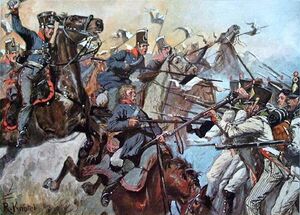Second Battle of Nagpure
The Second Battle of Nagpure (21 December - 30 December 1821) was an engagement by the Lucio-Galbadian forces led by General Sir. Benedict Humeray and the Auro-Sikh forces under Flórián Székely de Kisbátor. It is the second battle that took place in the city during the 1821 Maharashtra-Andhrapradesh Campaign.
Determined to defeat the Lucio-Galbadian forces for a second time in the city, Kisbátor attempted to commit a full counteroffensive against Humeray in an attempt to turn the tide. Kisbátor barely left any defenders during the Second Battle of Hyderabad because of the revolts in the regions that have been plaguing the Aurucolians and the Sikhs since September. Kisbátor hoped to save his strength for Nagpure, which was his last attempt to force the Allies back and regain the initiative. However, Humeray still continued the guerilla warfare. Kisbátor countered this by laying fake and ruse positions that would be raided by the raiders, as well as strengthening his defences. While the strategy worked, Humeray countered it by means of a scorched earth policy, changing the style of guerilla warfare waged by combining it with psychological warfare tactics, and isolating enemy positions.
Kisbátor's counteroffensive would ultimately end in defeat, as guerilla warfare continued to persist despite many countermeasures, as well as the hostility of the local Central Indiaen populace against the Sikhs and Aurucolians. Humeray continued to bleed Kisbátor until 30 December, when General Johannes Vandemeer successfully prevented General Martin Dobos's attack on the weak lines of Humeray's forces. This prompted the Aurucolians and Sikhs to retreat to Chindewara.
